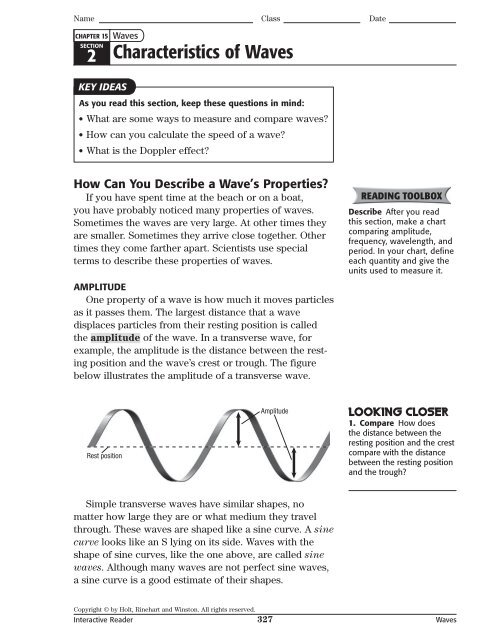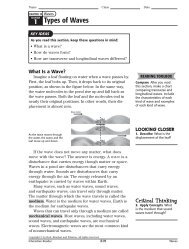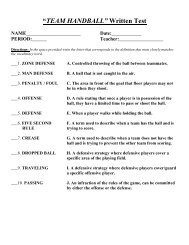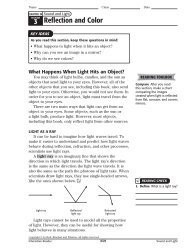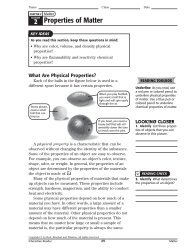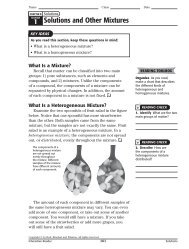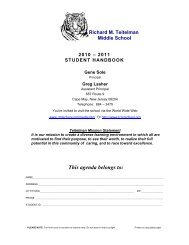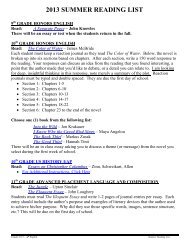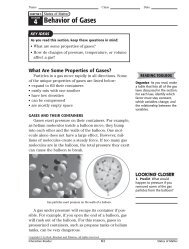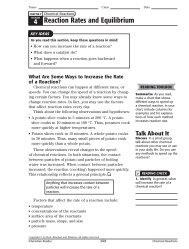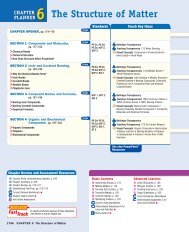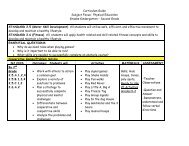2 Characteristics of Waves - Lower Cape May Regional School District
2 Characteristics of Waves - Lower Cape May Regional School District
2 Characteristics of Waves - Lower Cape May Regional School District
You also want an ePaper? Increase the reach of your titles
YUMPU automatically turns print PDFs into web optimized ePapers that Google loves.
Name Class Date<br />
CHAPTER 15<br />
2 <strong>Characteristics</strong> <strong>of</strong> <strong>Waves</strong><br />
SECTION<br />
<strong>Waves</strong><br />
KEY IDEAS<br />
As you read this section, keep these questions in mind:<br />
• What are some ways to measure and compare waves?<br />
• How can you calculate the speed <strong>of</strong> a wave?<br />
• What is the Doppler effect?<br />
How Can You Describe a Wave’s Properties?<br />
If you have spent time at the beach or on a boat,<br />
you have probably noticed many properties <strong>of</strong> waves.<br />
Sometimes the waves are very large. At other times they<br />
are smaller. Sometimes they arrive close together. Other<br />
times they come farther apart. Scientists use special<br />
terms to describe these properties <strong>of</strong> waves.<br />
AMPLITUDE<br />
One property <strong>of</strong> a wave is how much it moves particles<br />
as it passes them. The largest distance that a wave<br />
displaces particles from their resting position is called<br />
the amplitude <strong>of</strong> the wave. In a transverse wave, for<br />
example, the amplitude is the distance between the resting<br />
position and the wave’s crest or trough. The figure<br />
below illustrates the amplitude <strong>of</strong> a transverse wave.<br />
READING TOOLBOX<br />
Describe After you read<br />
this section, make a chart<br />
comparing amplitude,<br />
frequency, wavelength, and<br />
period. In your chart, define<br />
each quantity and give the<br />
units used to measure it.<br />
Rest position<br />
Amplitude<br />
<br />
1. Compare How does<br />
the distance between the<br />
resting position and the crest<br />
compare with the distance<br />
between the resting position<br />
and the trough?<br />
Simple transverse waves have similar shapes, no<br />
matter how large they are or what medium they travel<br />
through. These waves are shaped like a sine curve. A sine<br />
curve looks like an S lying on its side. <strong>Waves</strong> with the<br />
shape <strong>of</strong> sine curves, like the one above, are called sine<br />
waves. Although many waves are not perfect sine waves,<br />
a sine curve is a good estimate <strong>of</strong> their shapes.<br />
Copyright © by Holt, Rinehart and Winston. All rights reserved.<br />
Interactive Reader 327 <strong>Waves</strong>
Name Class Date<br />
SECTION 2<br />
<strong>Characteristics</strong> <strong>of</strong> <strong>Waves</strong> continued<br />
READING CHECK<br />
2. Define What is the<br />
wavelength <strong>of</strong> a longitudinal<br />
wave?<br />
WAVELENGTH<br />
The crests <strong>of</strong> ocean waves lapping up on the beach<br />
may be several meters apart. In contrast, ripples on a<br />
pond may be separated by only a few centimeters. In<br />
transverse waves, the distance between one crest and the<br />
next, or one trough and the next, is the wavelength. Ina<br />
longitudinal wave, the wavelength is the distance between<br />
two neighboring compressions or rarefactions.<br />
Generally, the wavelength is the distance between any<br />
two neighboring identical parts <strong>of</strong> a wave. The figure<br />
below shows the wavelengths <strong>of</strong> a transverse wave and a<br />
longitudinal wave.<br />
<br />
<br />
<br />
<br />
<br />
<br />
3. Review On the figure,<br />
label a crest, a trough, a compression,<br />
and a rarefaction.<br />
<br />
Not all waves have an obvious wavelength. Most sound<br />
waves have a complicated shape. That makes it difficult<br />
to determine their wavelengths.<br />
Scientists use the Greek letter lambda, , to represent<br />
wavelengths in equations. Wavelength is measured in<br />
units <strong>of</strong> length, such as meters or centimeters.<br />
<br />
4. Infer Wave A and wave B<br />
are the same kind <strong>of</strong> wave.<br />
Wave A has a smaller amplitude<br />
and longer wavelength<br />
than wave B. Which wave<br />
carries the most energy?<br />
AMPLITUDE, WAVELENGTH, AND ENERGY<br />
Remember that waves carry energy. There is a<br />
relationship between the amplitude <strong>of</strong> a wave and the<br />
amount <strong>of</strong> energy it carries. A wave with a large<br />
amplitude carries more energy than the same kind <strong>of</strong><br />
wave with a smaller amplitude.<br />
There is also a relationship between wavelength and<br />
energy. A wave with a large wavelength carries less energy<br />
than the same kind <strong>of</strong> wave with a smaller wavelength.<br />
Copyright © by Holt, Rinehart and Winston. All rights reserved.<br />
Interactive Reader 328 <strong>Waves</strong>
Name Class Date<br />
SECTION 2<br />
<strong>Characteristics</strong> <strong>of</strong> <strong>Waves</strong> continued<br />
PERIOD<br />
Imagine floating in an inner tube away from the shore<br />
<strong>of</strong> the ocean, as shown below. As waves pass you on<br />
their way to the shore, your body rises and falls. If you<br />
had a stopwatch, you could count the number <strong>of</strong> seconds<br />
between one crest or trough and the next. You would be<br />
measuring the period <strong>of</strong> the wave. The period <strong>of</strong> a wave<br />
is the time it takes for one full wavelength <strong>of</strong> the wave to<br />
pass a specific point.<br />
t = 0 s<br />
It takes 2 s for a full wavelength<br />
<strong>of</strong> this wave to pass the person.<br />
Therefore, the wave’s period is 2 s.<br />
t = 1 s<br />
t = 2 s<br />
<br />
5. Apply Concepts If it took<br />
3.5 s for the person to move<br />
up and down once on the<br />
wave, what would be the<br />
wave’s period?<br />
Scientists use the letter T to represent the period in<br />
equations. Period is measured in units <strong>of</strong> time, such as<br />
seconds.<br />
FREQUENCY<br />
The period <strong>of</strong> a wave is how long it takes for a full<br />
wavelength <strong>of</strong> the wave to pass a point. Suppose you<br />
were to measure the number <strong>of</strong> wavelengths that passed<br />
the point in a certain amount <strong>of</strong> time. Then, you would be<br />
measuring the frequency <strong>of</strong> the wave.<br />
The symbol for frequency is f. Its SI unit is the hertz (Hz).<br />
Hertz units measure the number <strong>of</strong> vibrations per second.<br />
One vibration per second is 1 Hz, and two vibrations per<br />
second is 2 Hz. The average person can hear sounds with<br />
frequencies as low as 20 Hz and as high as 20,000 Hz.<br />
There is a relationship between the frequency <strong>of</strong> a<br />
wave and its period. The equation below describes this<br />
relationship:<br />
frequency ______ 1<br />
period<br />
Math<br />
Skills<br />
6. Identify What is the relationship<br />
between period and<br />
frequency?<br />
f 1 __<br />
T<br />
Copyright © by Holt, Rinehart and Winston. All rights reserved.<br />
Interactive Reader 329 <strong>Waves</strong>
Name Class Date<br />
SECTION 2<br />
<strong>Characteristics</strong> <strong>of</strong> <strong>Waves</strong> continued<br />
READING CHECK<br />
7. Define What is the speed<br />
<strong>of</strong> a wave?<br />
Math<br />
Skills<br />
8. Calculate An ocean wave<br />
has a wavelength <strong>of</strong> 15.0 m.<br />
Its period is 10 s. What is the<br />
speed <strong>of</strong> the wave? Show<br />
your work.<br />
How Can You Measure Wave Speed?<br />
Remember that you can describe the speed <strong>of</strong> a moving<br />
object using units such as meters per second. The speed<br />
describes how long it takes the object to move a certain<br />
distance. In a similar way, you can describe the speed <strong>of</strong> a<br />
wave. The speed <strong>of</strong> a wave is the time it takes for one part<br />
<strong>of</strong> the wave to travel a certain distance.<br />
You can calculate the speed <strong>of</strong> a wave in two different<br />
ways. One way is divide the wave’s wavelength by its period:<br />
speed ___________<br />
wavelength<br />
period<br />
v = __ T<br />
Because frequency equals 1 ÷ T, you can also calculate<br />
the speed <strong>of</strong> a wave by multiplying its wavelength by its<br />
frequency:<br />
speed wavelength frequency<br />
v f<br />
Let’s look at an example <strong>of</strong> calculating the speed <strong>of</strong><br />
a wave. A piano string vibrates to produce a note. The<br />
sound waves the string produces have a frequency <strong>of</strong><br />
262 Hz and a wavelength <strong>of</strong> 1.30 m. What is the speed <strong>of</strong><br />
the sound waves?<br />
Step 1: List the given and<br />
unknown values.<br />
Step 2: Write the equation.<br />
Step 3: Insert the known values and<br />
solve for the unknown value.<br />
Given:<br />
frequency,<br />
f = 262 Hz<br />
wavelength,<br />
= 1.30 m<br />
v = f<br />
v = (262 Hz) (1.30 m)<br />
v = 341 m/s<br />
Unknown:<br />
speed, v<br />
Copyright © by Holt, Rinehart and Winston. All rights reserved.<br />
So, the wave’s speed is 341 m/s. This means that, in<br />
one second, a certain point on the wave travels 341 m.<br />
Do <strong>Waves</strong> Travel at the Same Speed in Every<br />
Medium?<br />
A wave’s speed depends on the medium through which<br />
the wave travels. In any particular medium, however,<br />
the speed <strong>of</strong> waves stays the same. The speed does not<br />
depend on the waves’ frequencies. The table on the next<br />
page shows the speed <strong>of</strong> sound in different mediums.<br />
Interactive Reader 330 <strong>Waves</strong>
Name Class Date<br />
SECTION 2<br />
<strong>Characteristics</strong> <strong>of</strong> <strong>Waves</strong> continued<br />
Speed <strong>of</strong> Sound in Different Mediums<br />
Medium<br />
Speed <strong>of</strong> sound (m/s)<br />
Air at 25 °C 3.46 × 10 2<br />
Water at 25 °C 1.49 × 10 3<br />
Gold 3 × 10 3<br />
<br />
9. Identify In which<br />
substance does sound move<br />
the fastest?<br />
DIFFERENCES IN WAVE SPEED<br />
The arrangement <strong>of</strong> molecules in a medium determines<br />
how quickly waves travel through the medium. In gases,<br />
the molecules are far apart and move randomly. In a gas, a<br />
molecule must travel through a lot <strong>of</strong> empty space before<br />
it bumps into another molecule. As a result, gas molecules<br />
have few chances to transfer energy to other molecules.<br />
Therefore, waves generally travel slowly in gases.<br />
In liquids such as water, the molecules are much closer<br />
than they are in gases. They can easily collide with each<br />
other and transfer their energy. Molecules in liquids act<br />
like masses on springs. They transfer vibrations from one<br />
molecule to the next. As a result, waves travel faster in<br />
liquids than in gases.<br />
Molecules in solids are even closer to each other. They<br />
are also bound tightly to each other. You can imagine<br />
molecules in solids as masses that are glued together.<br />
When one mass starts to vibrate, all the others start to<br />
vibrate almost immediately. As a result, waves travel very<br />
quickly through most solids.<br />
<br />
10. Infer The speed <strong>of</strong> a<br />
wave in a medium changes<br />
depending on the temperature<br />
<strong>of</strong> the medium. What do<br />
you think is the reason for<br />
this? (Hint: Remember what<br />
temperature describes.)<br />
How Fast Do Light <strong>Waves</strong> Travel?<br />
When you flip a light switch, light seems to fill the<br />
room instantly. However, like all waves, light waves take<br />
time to travel from place to place. All electromagnetic<br />
waves travel at the same speed in a given medium. In a<br />
vacuum, this speed is 3.00 × 10 8 m/s, or 186,000 miles per<br />
second. This value <strong>of</strong> the speed <strong>of</strong> light in empty space is<br />
a constant. Scientists give it the symbol c.<br />
Light doesn’t always travel at the speed that c represents.<br />
When light travels through a medium, such as air<br />
or water, it moves more slowly than in empty space. For<br />
example, light travels at 2.25 10 8 m/s in water.<br />
Copyright © by Holt, Rinehart and Winston. All rights reserved.<br />
Interactive Reader 331 <strong>Waves</strong>
Name Class Date<br />
SECTION 2<br />
<strong>Characteristics</strong> <strong>of</strong> <strong>Waves</strong> continued<br />
THE ELECTROMAGNETIC SPECTRUM<br />
Remember that visible light is just one kind <strong>of</strong><br />
electromagnetic wave. There are many different forms<br />
<strong>of</strong> electromagnetic waves. All travel at the same speed,<br />
but they have different wavelengths. For example, the<br />
wavelength <strong>of</strong> visible light varies from about 7.0 × 10 -7 m<br />
to about 4.0 × 10 -7 m. The different wavelengths <strong>of</strong><br />
visible light correspond to the different colors we see.<br />
<br />
11. Identify Which color<br />
<strong>of</strong> light has the shortest<br />
wavelength?<br />
<br />
12. Apply Concepts Name<br />
two forms <strong>of</strong> electromagnetic<br />
radiation that carry more energy<br />
than visible light waves.<br />
(Hint: What is the relationship<br />
between wavelength<br />
and energy?)<br />
READING CHECK<br />
13. Infer Which sound has a<br />
lower pitch, a bass guitar or<br />
a flute?<br />
Color <strong>of</strong> visible light<br />
Wavelength (m)<br />
Blue 4.75 × 10 -7<br />
Yellow 5.70 × 10 -7<br />
Red 6.80 × 10 -7<br />
Some forms <strong>of</strong> electromagnetic radiation, such as gamma<br />
rays and X rays, have shorter wavelengths than visible<br />
light. Other forms, such as radio waves and microwaves,<br />
have longer wavelengths than visible light. The full range<br />
<strong>of</strong> wavelengths <strong>of</strong> all electromagnetic waves is called the<br />
electromagnetic spectrum.<br />
How Can Motion Affect the Properties <strong>of</strong><br />
<strong>Waves</strong>?<br />
Imagine that you are standing on a corner as an ambulance<br />
rushes by. As the ambulance passes, the sound <strong>of</strong><br />
its siren changes. This happens because the ambulance is<br />
moving.<br />
The pitch <strong>of</strong> a sound describes how high or low the<br />
sound is. High sounds, such as a bird singing, have a high<br />
pitch. Pitch is determined by the frequency or wavelength<br />
<strong>of</strong> a sound. The higher the frequency <strong>of</strong> a sound, the<br />
higher the pitch.<br />
Suppose you could see the sound waves from the<br />
ambulance, as in the figure on the next page. When the<br />
ambulance stands still, sound waves from its siren spread<br />
out evenly in all directions. The pitch <strong>of</strong> the sound is the<br />
same no matter where you stand.<br />
As the ambulance travels toward you, the waves are<br />
squeezed into a smaller space. When it is moving away,<br />
the waves are stretched. This squeezing and stretching<br />
affects the pitch <strong>of</strong> the sound you hear. If the ambulance<br />
is moving toward you, the pitch sounds higher. If it is<br />
moving away from you, the pitch sounds lower.<br />
Copyright © by Holt, Rinehart and Winston. All rights reserved.<br />
Interactive Reader 332 <strong>Waves</strong>
Name Class Date<br />
SECTION 2<br />
<strong>Characteristics</strong> <strong>of</strong> <strong>Waves</strong> continued<br />
When the ambulance is<br />
not moving, the sound<br />
waves have the same<br />
frequency everywhere.<br />
No matter where you<br />
stand, the siren sounds<br />
the same.<br />
Observer B<br />
Observer A<br />
When the ambulance<br />
is moving, the sound<br />
waves are stretched or<br />
compressed. Observer A<br />
hears a higher-pitched<br />
siren than Observer B.<br />
<br />
14. Identify In the bottom<br />
image, circle the waves with<br />
the highest frequency.<br />
Consider the situation in which the ambulance is moving<br />
toward you. Between the time when the siren emits<br />
one sound wave and the next one, the ambulance moves<br />
forward. The movement shortens the distance between<br />
wave fronts. As a result, the sound waves reach your ear<br />
at a higher frequency than normal. They sound higherpitched<br />
than they would if the ambulance were parked.<br />
The opposite happens if the ambulance is moving<br />
away from you. The movement lengthens the distance<br />
between wave fronts. The sound waves reach your ear at<br />
a lower than normal frequency. So, you hear the siren at a<br />
lower pitch than you would if the ambulance stayed still.<br />
This change in the observed wavelength <strong>of</strong> a wave<br />
when the source and observer are moving relative to one<br />
another is called the Doppler effect. The Doppler effect<br />
happens any time the source and the observer are moving<br />
relative to each other. The effect occurs for all types <strong>of</strong><br />
waves, including light and radio waves.<br />
Scientists use the Doppler effect in several different<br />
ways. For example, meteorologists use the effect to help<br />
them track storms. Astronomers rely on the Doppler effect<br />
to measure the speeds at which galaxies are moving away<br />
from Earth.<br />
<br />
15. Infer If you were riding<br />
in the ambulance, would<br />
the pitch <strong>of</strong> its siren seem to<br />
change? Explain your answer.<br />
Copyright © by Holt, Rinehart and Winston. All rights reserved.<br />
Interactive Reader 333 <strong>Waves</strong>
Name Class Date<br />
Section 2 Review<br />
SECTION VOCABULARY<br />
amplitude the maximum distance that the<br />
particles <strong>of</strong> a wave’s medium vibrate from<br />
their rest position<br />
Doppler effect an observed change in the<br />
frequency <strong>of</strong> a wave when the source or<br />
observer is moving<br />
frequency the number <strong>of</strong> cycles or vibrations<br />
per unit <strong>of</strong> time; also the number <strong>of</strong> waves<br />
produced in a given amount <strong>of</strong> time<br />
period in physics, the time that it takes a<br />
complete cycle or wave oscillation to occur<br />
wavelength the distance from any point on a<br />
wave to an identical point on the next wave<br />
1. Identify On the figure below, label the amplitude and wavelength <strong>of</strong> the wave.<br />
2. Calculate Green light has a wavelength <strong>of</strong> 5.20 × 10 -7 m. The speed <strong>of</strong> light is<br />
3.00 × 10 8 m/s. What is the frequency <strong>of</strong> green light waves? Show your work.<br />
(Hint: 1 m/s ÷1m=1Hz.)<br />
3. Explain A scientist strikes a long metal bar with a hammer. The energy produces<br />
waves that travel through the bar and through the air. Which will reach the end <strong>of</strong><br />
the bar first, the wave traveling through the bar or the one traveling through the<br />
air? Explain your answer.<br />
4. Describe As the frequency <strong>of</strong> a wave increases, what happens to its period and<br />
wavelength if its speed stays the same?<br />
Copyright © by Holt, Rinehart and Winston. All rights reserved.<br />
Interactive Reader 334 <strong>Waves</strong>


